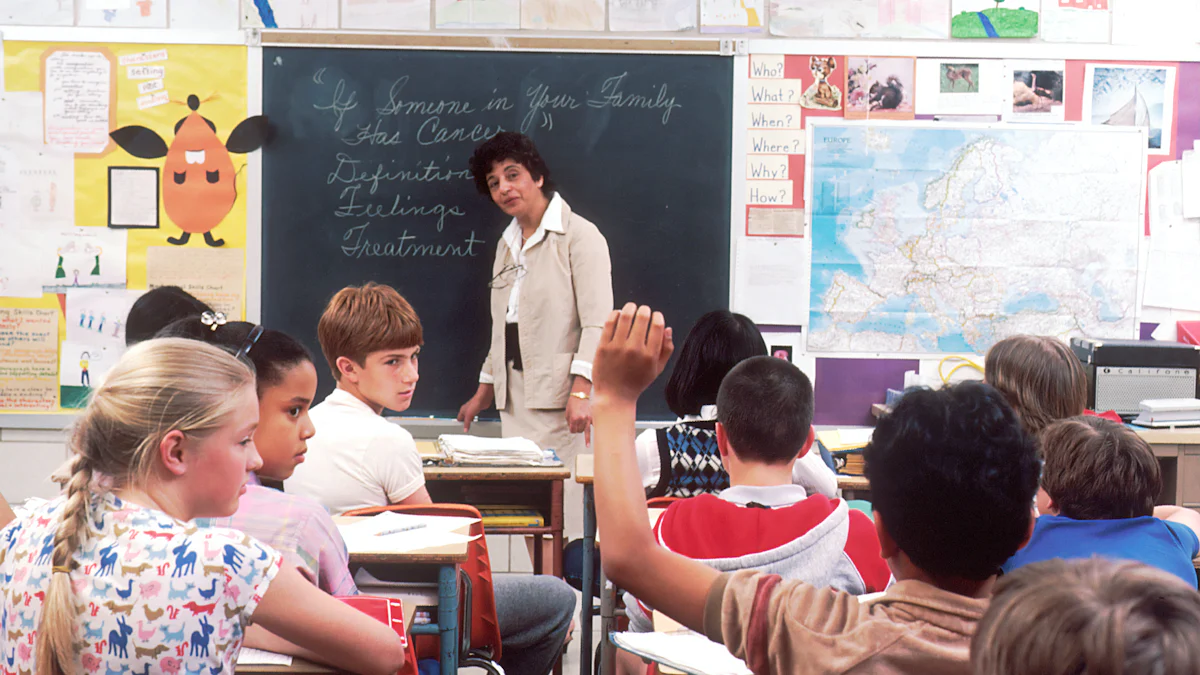Teaching Kids the Importance of Patience and Delayed Gratification

Patience means waiting calmly for something. Delayed gratification involves resisting immediate rewards to achieve greater benefits later. Teaching these skills shapes a child's future. Children who learn patience often excel academically and socially. Studies show that children with delayed gratification skills have higher SAT scores and better stress responses. The importance of patience lies in its ability to foster resilience and self-control. Encouraging kids to wait helps them focus on long-term goals. These skills build a foundation for success and emotional well-being.
Understanding Patience and Delayed Gratification
What is Patience?
Definition and examples
Patience means staying calm while waiting for something important. Imagine a child waiting for a birthday gift. The anticipation builds excitement, but patience helps manage emotions. Another example involves waiting in line at an amusement park. The thrill of the ride becomes more rewarding when patience is practiced.
Everyday scenarios requiring patience
Everyday life offers many opportunities to practice patience. Waiting for a homemade meal teaches patience. Completing a challenging puzzle requires patience and focus. Children learn patience when they wait for their turn during a game. Each scenario strengthens emotional control and resilience.
What is Delayed Gratification?
Definition and examples
Delayed gratification involves resisting immediate rewards for greater future benefits. Picture a child choosing to save allowance money for a desired toy instead of buying candy. This decision reflects delayed gratification. Another example includes studying for a test instead of playing video games. Success in academics often results from such choices.
The marshmallow test and its implications
The famous marshmallow test illustrates delayed gratification. Children faced a choice: eat one marshmallow immediately or wait for two marshmallows later. Those who waited often achieved higher SAT scores and better stress responses. This experiment highlights the power of self-control. Delayed gratification leads to success in various life aspects, including social skills and emotional well-being.
Importance of Patience and Delayed Gratification
Benefits for Child Development
Emotional regulation
Patience plays a crucial role in emotional regulation. Children who learn patience can manage their emotions better. Imagine a child waiting for a turn on the swing. The wait teaches control over impulses. This skill helps in various life situations. Emotional regulation leads to healthier relationships. It also reduces impulsive behavior.
Academic success
Patience contributes to academic success. Children with patience handle academic pressure effectively. The ability to delay gratification encourages children to focus on long-term goals. A study in the Journal of Personality found that children who practiced delayed gratification achieved higher academic scores. These children often excel in exams and projects. Patience fosters concentration and perseverance.
Long-term Life Skills
Building resilience
Resilience is vital in overcoming life's challenges. Patience builds resilience by teaching persistence. Children learn to face setbacks without giving up. Imagine a child working on a difficult puzzle. The process strengthens problem-solving skills. Resilient children adapt to changes faster. They thrive in both personal and professional environments.
Enhancing decision-making
Patience enhances decision-making abilities. Children who practice delayed gratification make thoughtful choices. The famous Marshmallow Experiment highlighted this concept. Children who waited for a second marshmallow displayed better decision-making skills later in life. These skills lead to wiser financial and career decisions. Patience and delayed gratification create a foundation for success.
Strategies for Teaching Patience
Setting Family Goals
Setting family goals plays a vital role in teaching kids patience. Involving children in goal-setting encourages them to take ownership of their actions. Children learn the value of working towards something meaningful. Parents can start by discussing what the family wants to achieve together. This could be saving for a vacation or completing a home project. Each family member can contribute ideas and suggestions. This involvement fosters a sense of responsibility and commitment.
Celebrating achievements motivates children to continue practicing patience. Recognizing progress boosts confidence and reinforces positive behavior. Parents can organize small celebrations when a goal is met. A family dinner or a fun outing can serve as a reward. Celebrations create lasting memories and highlight the importance of patience. Children feel appreciated and motivated to set new goals.
Providing Choices
Providing choices empowers children and teaches them about patience. Allowing children to make decisions gives them a sense of control. Kids learn that their choices have consequences. Parents can present options like choosing between immediate rewards or waiting for something better. For example, children might decide between a small treat now or a larger one later. This practice helps children understand the value of delayed gratification.
Discussing consequences of choices enhances decision-making skills. Parents can guide children through the thought process. Questions like "What will happen if you choose this?" encourage critical thinking. Children learn to weigh pros and cons before making decisions. This skill proves valuable in various life situations. Teaching kids to evaluate outcomes builds confidence and patience.
The Goal Mama App and Nurse Dashboard emphasize the importance of goal setting in programs like the Nurse-Family Partnership. Successful family goal-setting strategies increase engagement and retention. These strategies can be adapted for teaching kids patience. Families can create a supportive environment where patience becomes a shared value.
Encouraging Delayed Gratification

Reward Systems
Creating a reward chart provides a visual representation of progress. Children see their achievements and feel motivated to continue. Each completed task earns a sticker or mark on the chart. This tangible evidence of success encourages children to work towards goals. Parents can set specific rewards for reaching milestones. A family outing or a special treat serves as motivation.
Balancing immediate and delayed rewards teaches children valuable lessons. Immediate rewards offer instant satisfaction. Delayed rewards provide greater benefits over time. Parents can present choices between a small, quick reward or a larger, delayed one. Children learn to weigh options and make thoughtful decisions. This practice enhances decision-making skills and fosters patience.
Practicing Waiting
Activities that require waiting help children develop patience. Gardening offers a perfect example. Children plant seeds and wait for them to grow. The process teaches patience and responsibility. Baking also requires waiting. Children mix ingredients and watch as the dough rises. These activities provide opportunities to practice delayed gratification.
Discussing feelings during the wait helps children understand emotions. Parents can ask questions about how waiting makes children feel. Open conversations encourage emotional awareness and expression. Children learn to identify and manage emotions. This skill proves valuable in various life situations. Understanding emotions leads to better social interactions and relationships.
Children who master delayed gratification often experience numerous benefits. Studies show higher SAT scores and better stress responses. Improved social skills and healthier lifestyle choices also result from this practice. Parents play a crucial role in teaching these skills. Encouraging delayed gratification builds a foundation for lifelong success.
Overcoming Challenges
Common Obstacles
Impatience in children
Impatience often appears as a significant challenge. Children naturally desire immediate satisfaction. Many struggle to wait for rewards. This impatience can hinder their ability to learn patience and delayed gratification. Bettinger and Slonim discovered that children exhibit high discount rates, indicating impatience. Boys often show less patience than girls. Older children tend to develop more patience over time. Understanding these tendencies helps parents address impatience effectively.
External influences
External influences also pose challenges. Media and advertisements often promote instant gratification. Children face pressure from peers who may not value patience. These factors can undermine efforts to teach patience and delayed gratification. Parents must recognize these influences. Awareness allows for proactive measures to counteract negative impacts. Creating a supportive environment at home becomes essential.
Solutions and Tips
Consistency in teaching
Consistency plays a crucial role in overcoming challenges. Regular practice reinforces patience and delayed gratification. Parents should establish routines that encourage waiting. Activities like gardening or baking provide opportunities for practice. Consistent reinforcement helps children internalize these skills. Mischel's experiments revealed that children who practiced patience succeeded in various life aspects. Consistency ensures long-term benefits.
Positive reinforcement
Positive reinforcement motivates children to embrace patience. Rewarding children for waiting encourages continued effort. A reward chart visually tracks progress. Stickers or marks celebrate achievements. Parents can offer small rewards for reaching milestones. Positive reinforcement builds confidence and enthusiasm. Children feel valued and motivated to practice patience. This approach fosters a positive learning environment.
Teaching patience and delayed gratification offers children lifelong benefits. These skills foster emotional well-being and academic success. Parents can implement strategies like setting goals and providing choices. Consistent practice builds resilience and enhances decision-making. Success often requires choosing discipline over distraction. Encourage ongoing practice to reinforce these valuable lessons. Create an environment where patience thrives. Activities like gardening or using Apple Music and Alexa for timed tasks can help. Inspire children to embrace the journey of growth and achievement.
See Also
Teaching Children the Value of Patience
Teaching Kids the Power of Gratitude
Helping Children Master Self-Calming Techniques

